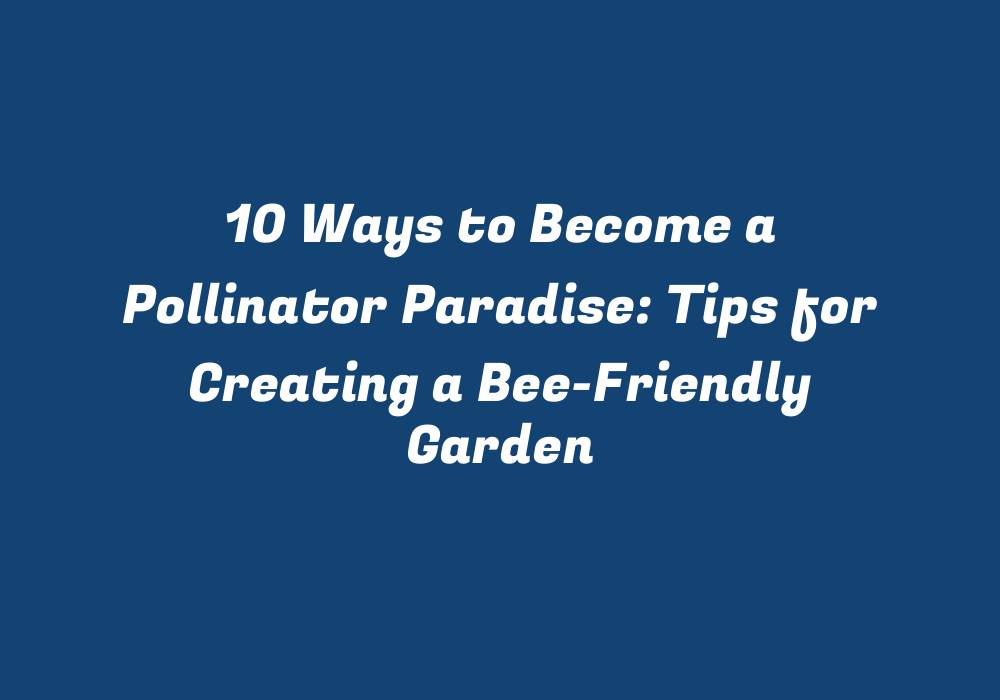10 Ways to Become a Pollinator Paradise: Tips for Creating a Bee-Friendly Garden
Pollination is a vital part of the natural cycle. It is the process through which pollen from flowers is transferred between them, ultimately leading to fruit formation and seed production. The importance of this process cannot be overstated, as it ensures our food security and the survival of countless plant species. However, the decline in insect populations, particularly bees, has become a serious concern for environmentalists and scientists worldwide. As a result, it is crucial to create an inviting and thriving environment for pollinators like bees in your garden.
1. Plant Bee-Friendly Flowers
One of the most significant ways to attract bees to your garden is by including flowers that they love. Choose a variety of native plants and blooming species, as these often provide the right pollen for local insects. Popular choices include lavender, sunflowers, daisies, marigolds, echinacea, bee balm, and buddleja. Remember to have both annuals and perennials in your garden, ensuring a continuous source of nectar and pollen throughout the year.
2. Provide Nectar-Rich Plants
Although bees primarily seek out pollen for nourishment, they also need nectar as a secondary food source. Therefore, planting a combination of flowers with both nectar and pollen is essential to cater to the bees’ diverse dietary needs. Some plants that provide both are lavender, buddleja, honeysuckle, salvia, and hydrangea. These plants not only attract bees but also offer additional benefits such as fragrance and ornamental beauty.
3. Create a Varied Flower Arrangement
Different species of bees have distinct preferences for the shapes, colors, and sizes of flowers. To cater to their varying needs, create a diverse array of blooms with different flower forms in your garden. Include both single-flowered plants and double-flowered varieties in shades like yellow, blue, white, purple, and pink. This variety will increase the chances of attracting a wide range of bees.
4. Offer Water Sources
A thriving garden environment also includes offering water sources for pollinators to quench their thirst. Provide shallow dishes or bowls filled with clean water, preferably placed near the flowers they frequent. The presence of a nearby source of water will encourage bees to spend more time in your garden and promote healthy hydration habits.
5. Minimize Pesticide Use
Insecticides, herbicides, and other chemical-based gardening products can have a significant impact on bee populations by disrupting their natural life cycles or poisoning them directly. Therefore, it is crucial to limit the use of such substances as much as possible in your garden. Instead, opt for organic alternatives like neem oil, homemade insecticidal soap, or pesticide-free products available at local nurseries.
6. Encourage Plant Diversity
A bee-friendly garden should consist of various plant species to provide a more comprehensive food source for pollinators. Include flowering trees, shrubs, and ground covers alongside your traditional perennial and annual plants. This diversity will not only attract a greater number of bees but also create a more harmonious environment by supporting different species of flora.
7. Provide Shelter and Nesting Sites
Bees need sheltered spots for nesting, roosting, and overwintering during the colder months. Create a bee-friendly haven by incorporating log piles, dead wood, or untreated wooden structures in your garden. Include stonewalls to create crevices where bees can hide from predators and extreme temperatures. Also, consider planting native shrubs like spirea and berry bushes that provide both shelter and food for various species of bees.
8. Embrace Native Plants
Native plants are already adapted to the local climate and soil conditions in your area, making them an excellent choice for attracting native bee species that have evolved alongside these flora. Opt for locally sourced seeds or seedlings, as they will likely thrive better than non-native species. This strategy helps support the delicate ecological balance of your garden by promoting coexistence between local plants and pollinators.
9. Create a Bee-Friendly Meadow
If you have ample outdoor space, consider establishing a bee meadow in a portion of your garden. A wildflower meadow allows for the growth of various flowering plants that attract pollinators and provide a natural habitat for them to thrive. Meadows also promote biodiversity by supporting numerous species of flora and fauna, ultimately contributing to a healthy ecosystem.
10. Educate Yourself and Others
Becoming a pollinator paradise is not just about creating an appealing garden for bees – it also involves spreading awareness among your friends, family, and community on the importance of promoting biodiversity and protecting pollinators. Share your knowledge, experiences, and tips with others to create a collective effort towards preserving these vital insects that play a crucial role in our environment.
In conclusion, transforming your garden into a bee-friendly paradise can not only boost the health of the local ecosystem but also contribute to a more sustainable future for all living organisms on our planet. By incorporating these 10 tips, you will help create an inviting haven for pollinators like bees and foster their role in maintaining the delicate balance between plants and other wildlife.
